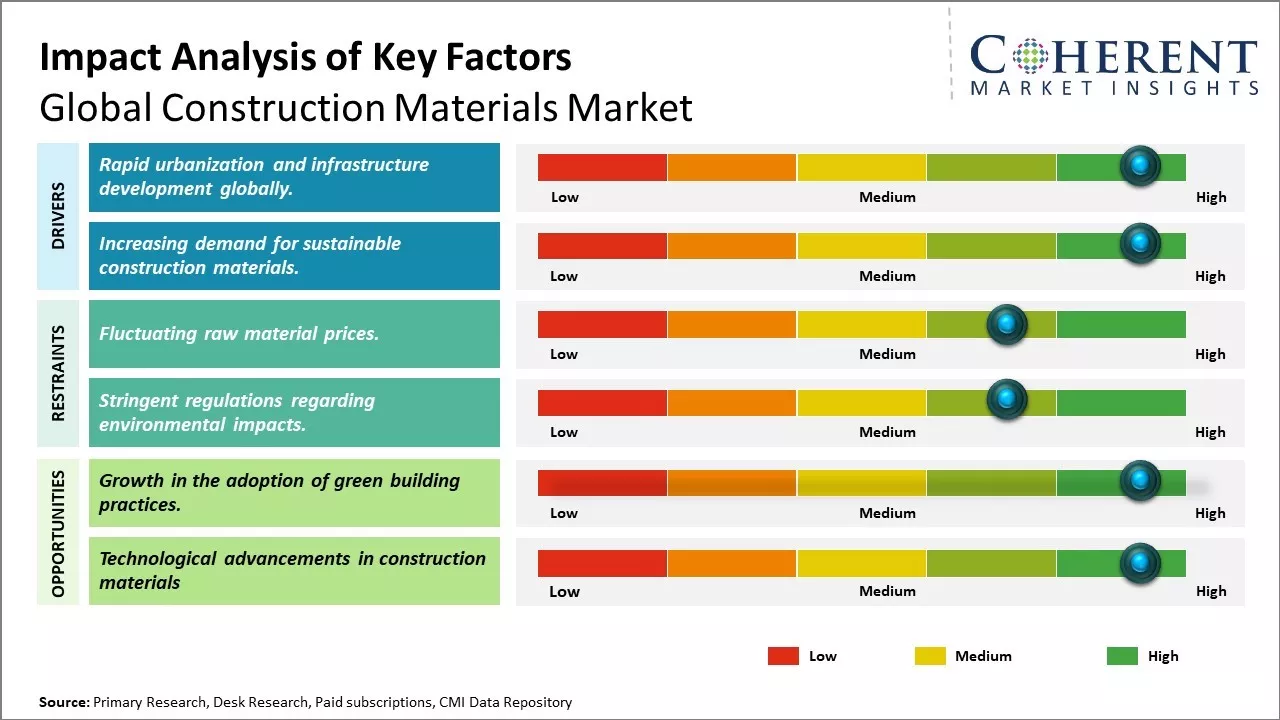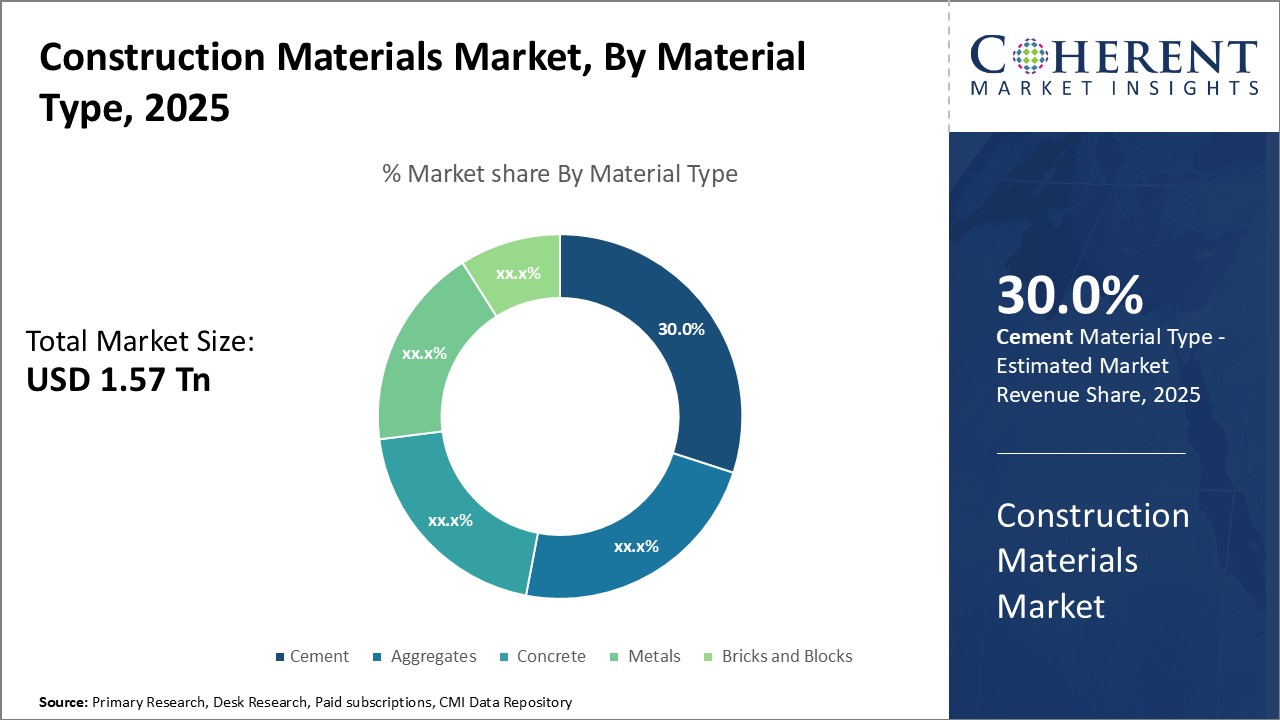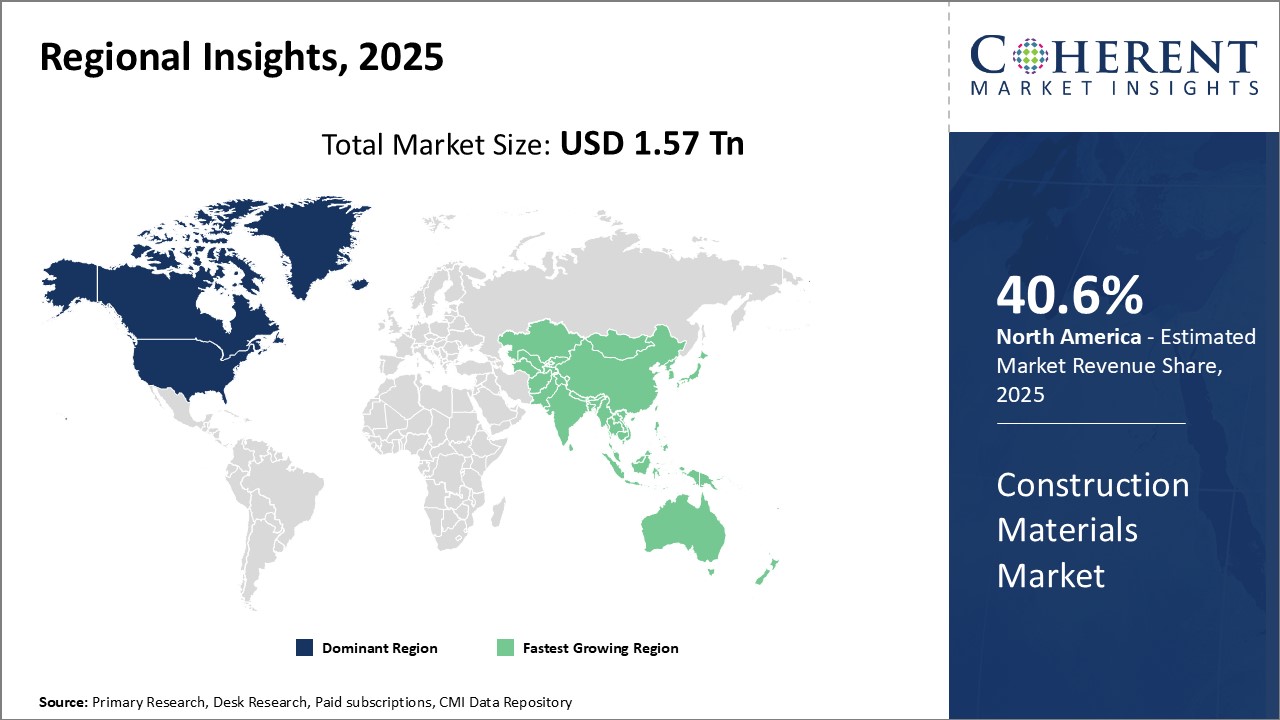Construction Materials Market Size and Trends
The global construction materials market is estimated to be valued at USD 1.57 Tn in 2025 and is expected to reach USD 2.47 Tn by 2032, exhibiting a compound annual growth rate (CAGR) of 6.7% from 2025 to 2032.

Discover market dynamics shaping the industry: Download Free Sample
Increasing urbanization and infrastructure development projects across both developed and developing countries will drive the demand for construction materials. Additionally, growing investments towards non-residential construction such as commercial buildings, hospitals, and transport infrastructure are also expected to fuel the market growth. For instance, according to data from Statistics Canada released in July 2025, investment in non-residential construction in Canada increased by 0.6% in May 2025 compared to April 2025, reaching a total of US$ 6,376.4 million. Notably, the province of Newfoundland and Labrador experienced an 11.1% surge in investment, underscoring the regional variations in investment growth across Canada. These figures indicate a positive trend in non-residential construction investment, which can drive economic development, job creation, and infrastructure improvements in the affected regions. Furthermore, rapid industrialization and economic development in emerging nations of Asia Pacific and Middle East and Africa will continue to provide opportunities for construction material manufacturers globally. Meanwhile, rapid advancements in construction technologies and adoption of green building solutions will help counter certain challenges and further accelerate the market expansion. However, volatility in raw material prices may hind the construction materials market growth during the forecast period.
Rapid urbanization and infrastructure development globally
The global construction industry is witnessing rapid urbanization at an unprecedented rate. For instance, according to data by Invest India in 2022, The construction Industry in India is expected to reach US$ 1.4 Tn by 2025. As more and more people are moving to urban areas from rural regions in search of better live ability and employment opportunities, cities need to develop infrastructure at a similar pace to accommodate growing population. It is estimated that around 68% of the world population will be living in urban areas by 2050 which is a massive jump from 55% in 2018. Developing economies in Asia Pacific, Africa and Latin America are expected to drive this urbanization trend. This explosion of urban population coupled with lack of adequate housing and logistic infrastructure is compelling governments across the world to focus on construction of new townships, smart cities, roads, metros, airports, etc.
Countries like India and China having huge rural population migrating to cities are investing multi-billion dollars on rapid development of urban centers. India alone is developing 100 smart cities under its flagship smart city mission to equip its rising middle class with modern lifestyle. In last few years, Indian government's focus on infrastructure has resulted in major construction of new highways, ports, power generation plants etc. which is enhancing connectivity and catering rising demands. Similarly, Chinese government's continued thrust on infrastructure through initiatives like 'Belt and Road' is reshaping global construction industry landscape. Speedy implementation of infrastructure projects is necessary to keep pace with fast tracking industrialization.
While advanced nations already have well developed infrastructure, they are also witnessing constant upgradation and expansion drive to support aging population and evolving transportation needs. For example, developed economies in Europe and America are investing heavily on developing high-speed rail corridors, modernizing airports and boosting renewable energy infrastructure. Construction of new tunnels, bridges and buildings are regularly commissioned to stay ahead of competition.
Market Concentration and Competitive Landscape

Get actionable strategies to beat competition: Download Free Sample
Increasing demand for sustainable construction materials
With rising environmental concerns and focus on fighting climate change, there is growing demand for sustainable construction materials globally. Consumers as well as regulators are preferring eco-friendly alternatives that cut down carbon footprint and promote circularity. Use of materials like bamboo, straw bales, timber, seaweed, etc. that utilize renewable and natural resources are gaining traction. There is also thrust on innovative materials made from industrial and agricultural waste. For example, construction blocks are now being made from fly ash, slag, and other manufacturing byproducts that divert them from landfills. Similarly, recycled plastics are finding applications in building insulation, carpet backing and pipes.
Green cement variants using fly ash, slag and rice husk ash as partial replacements are reducing clinker dependence and lowering emissions. Hybrid cement blends infused with industrial byproducts offer strength with lowered carbon impact. These sustainable cementitious materials conform to codes while delivering economic and eco benefits. Use of recycled aggregates, glass and construction waste is also escalating to create circular loops in infrastructure projects. Admixtures like waste plastic molasses are employed to cut consumption of virgin materials in concrete.
Building design optimization through renewable energy integrations, passive heating/cooling, superior insulation and water harvesting are equally pivotal. Practices like green roofing, use of biodynamic materials, sustainable water and waste management systems are gaining prominence. Developers are incorporating green building certification compliances to attract environment-conscious homebuyers and tenants. Governments across major markets are formulating policies promoting greener buildings through tax rebates, incentives and mandates.
With severe impacts of climate change becoming visible, the call for future-proofing construction is gaining urgency. The sector is gradually shifting focus towards sustainable development goals through eco-centric innovations. This transition will keep pushing demand for advanced green materials globally going forward.
Key Takeaways from Analyst:
The market is driven by robust growth in residential and commercial construction activities across major economies. Rapid urbanization and rising disposable incomes are increasing the demand for residential buildings in developing countries. Additionally, growing infrastructure investments by governments to develop roads, bridges, ports, airports etc. are boosting usage of cement, steel, and other construction raw materials.
While growth in emerging markets will continue providing opportunities, recovery in construction spending in developed markets like the U.S. and Western Europe will further support material demand. Moreover, focus on greener and more sustainable infrastructure is opening opportunities for materials manufacturers to develop eco-friendly substitutes.
However, rising raw material prices remain a challenge due to supply constraints and geo-political risks. Escalating trade tensions also increase uncertainty and risk of higher tariffs. Use of prefabricated or precast materials is increasing efficiency but also intensifying competition. The market also faces concerns over carbon emissions from cement production.
Market Challenge - Fluctuating raw material prices
The global construction materials market is facing a major challenge due to fluctuating raw material prices. Construction materials require a wide range of raw materials such as cement, steel, aluminum, wood, aggregates, and others. However, the prices of these raw materials are prone to fluctuate frequently depending on various global and regional economic and political factors. Sometimes there are sharp price spikes due to factors like supply disruptions, trade wars, increase in energy costs. This makes accurate market forecasting and demand planning very difficult for construction materials manufacturers. Fluctuating raw material costs also impact their production budgets and ability to offer competitive prices to customers. It introduces an element of unpredictability in their profit margins. To address volatility in input costs, companies have to proactively diversify their sourcing strategies and maintain adequate inventory levels. However, this also increases their working capital needs. If frequent and sharp rises in raw material prices are not passed on to customers, it can significantly affect the bottom lines of construction materials companies.
Market Opportunity - Growth in the adoption of green building practices
The global construction materials market has a significant opportunity in the growing adoption of green building practices across the world. With rising environmental concerns, developers and building owners are increasingly focusing on green construction techniques that minimize carbon footprint and promote sustainability. This shifts the demand towards eco-friendly construction materials like recycled aggregates, engineered wood, green cement, bio-based insulation, and others. It provides construction materials manufacturers an avenue to develop new sustainable product varieties and materials. They can also promote their existing ecological offerings aggressively. Transitioning to a greener portfolio helps companies enhance their brand image and positioning in the industry. Demand for green materials is expected to rise substantially in the coming years driven by government regulations and incentives encouraging sustainable development. This opens up a major growth vertical for construction materials suppliers worldwide.

Discover high revenue pocket segments and roadmap to it: Download Free Sample
Insights by material type: Cement Leads the Global Construction Materials Market due to Wide Applications
Cement is expected to hold 30.0% share of the global construction materials market in terms of material type in 2025, due to its exceptionally wide range of applications across residential, commercial, infrastructure and industrial construction. Cement is a crucial binding agent used in making concrete, which is the most abundantly used construction material worldwide. Concrete finds applications in building structures like buildings, bridges, roads and other infrastructure projects.
The growth in the global construction industry has significantly driven demand for cement over the past few decades. Mega infrastructure projects like large bridges, tunnels and dams require huge volumes of cement for manufacturing concrete. Rapid urbanization and growth of urban populations have also fueled the rise of new housing and commercial real estate construction projects, thereby boosting cement consumption. Countries with large emerging economies like China and India have been spearheading world cement demand growth through their ambitious infrastructure development programs and housing sector expansion.
On the residential construction front, cement is a basic element in constructing cement concrete buildings and housing complexes across both developed and developing markets. Commercial construction too has witnessed a boom in new malls, office spaces, hospitality structures and other buildings, propelling cement demand. Even industrial construction needs cement for making factory sheds, warehouses and other industrial units. The current pace of global infrastructure development encompassing roads, metros, ports and more has created sustained opportunities in the cement market. Looking ahead, rising investments in modern infrastructure platforms and ongoing urbanization transitions will likely ensure steady demand flow for cement as the core material type in the construction industry.
Insights by application: Residential Construction Drives the Global Construction Materials Demand
Among various application segments, residential construction is expected to contribute 43.9% share of the global construction materials market in 2025. Growing urban populations and rising incomes across developing nations have enhanced housing needs manifold. Countries undergoing rapid economic development like China, India, and several Southeast Asian countries have witnessed a large residential construction boom over the past decade to house their burgeoning middle classes and migrant labor forces.
The swelling numbers of nuclear family units and rising disposable earnings particularly among younger demographics have encouraged self-owned home buying. This has stimulated enormous residential projects involving multi-storied apartments, condominiums and townships. China alone has seen the addition of dozens of new “satellite cities” consisting of residential complexes to accommodate its urbanizing population.
Even developed economies in Europe and North America have experienced healthy activity in the residential remodeling and extension construction sector driven by favorable financing scenarios and preferences for spacious living amid the COVID-19 pandemic. The affordable housing category too has drawn significant government support through varied subsidized schemes. Raw material suppliers have leveraged such opportunities to provide construction materials for everything from housing foundation to finishing works.
Going forward, sustained rural to urban population shifts instigated by economic growth will sustain the residential construction boom globally. Emerging trends like nuclearization and larger living spaces will further bolster residential construction material consumption. Demographic dividends in populous developing nations ensure long-term prospects for residential building materials well into the foreseeable future.
Regional Insights

Need a Different Region or Segment? Download Free Sample
North America remains the dominant region in the global construction materials market. The region is expected to hold 40.6% of the market share in 2025. The U.S. accounts for the bulk of North America's market size owing to the presence of major industry players and a robust pipeline of construction projects across infrastructure, commercial and residential sectors. U.S.-based companies have established a strong hold across North American nations and have expanded their exports globally as well. The free flow of materials within the North American Free Trade Agreement NAFTA trade bloc has also allowed the region to emerge as a price leader with North American producers enjoying economies of scale.
The Asia Pacific region has emerged as the fastest growing market for construction materials in recent years, primarily driven by China and India. Rapid urbanization, growing industrialization and infrastructure development have pumped huge investments into building activity in Asia Pacific. The Chinese government's continued focus on building new cities, high-speed rail links, and affordable housing has stimulated demand for cement, steel, and aggregates. Indian government's ambitious initiatives such as Smart Cities Mission and Housing for All by 2022 have created lucrative opportunities for construction materials firms to participate in this largely untapped market. The availability of low-cost labor and abundant raw material reserves in Asia Pacific have empowered producers to continuously expand capacities and effectively meet the rising consumption within the region as well as from outside markets.
While North America and Asia Pacific are the dominant forces currently, the Middle Eastern region is witnessing substantial growth prospects, especially Western Asia led by the Gulf countries. Multi-billion-dollar investments towards projects supporting infrastructural development connected to trade, tourism and real estate have emerged as key growth levers. Countries in this region also import construction materials on large scale to fulfill their requirements, offering global players new supply avenues to tap into.
Market Report Scope
Construction Materials Market Report Coverage
| Report Coverage | Details | ||
|---|---|---|---|
| Base Year: | 2024 | Market Size in 2025: | USD 1.57 Tn |
| Historical Data for: | 2020 To 2024 | Forecast Period: | 2025 To 2032 |
| Forecast Period 2025 to 2032 CAGR: | 6.7% | 2032 Value Projection: | USD 2.47 Tn |
| Geographies covered: |
|
||
| Segments covered: |
|
||
| Companies covered: |
LafargeHolcim, HeidelbergCement, CRH plc, Cemex S.A.B. de C.V., Martin Marietta Materials, Inc., Boral Limited, Lehigh Hanson, Inc., Saint-Gobain, Taiheiyo Cement Corporation, Groupe Eiffage, China National Building Material Group Corporation, Anhui Conch Cement Company, UltraTech Cement Limited, James Hardie Industries plc, Knauf GIPS KG, Kiewit Corporation, Sika AG, Fletcher Building Limited, BASF SE, and Ytong (Xella Group) |
||
| Growth Drivers: |
|
||
| Restraints & Challenges: |
|
||
Uncover macros and micros vetted on 75+ parameters: Get instant access to report
Construction Materials Industry News
- In January 2024, LafargeHolcim , a Swiss multinational company launched a new range of eco-friendly cement products designed to significantly reduce carbon emissions in the construction industry. This innovative product line incorporates sustainable materials and advanced manufacturing processes, reflecting the company's commitment to environmental responsibility. By offering these eco-friendly options, LafargeHolcim aims to support builders and developers in achieving their sustainability goals while contributing to a greener future for the construction sector. This initiative underscores the company's dedication to reducing its carbon footprint and promoting sustainable practices within the industry.
- In 2023, Heidelberg Materials, a leading global supplier of building materials, opened a state-of-the-art cement plant in Mitchell, Indiana, U.S. This new facility represents a significant investment in the company's North American operations and showcases its commitment to innovation and sustainability. The plant is equipped with advanced technologies that optimize energy efficiency, reduce emissions, and enhance product quality. By strategically locating the plant in Mitchell, Heidelberg Materials aims to better serve its customers in the Midwest region while contributing to the growth and development of the local economy. This milestone reflects the company's ongoing efforts to expand its global footprint and deliver high-performance, eco-friendly building solutions to the construction industry.
- In 2023, Cemex S.A.B. de C.V. announced a partnership with a technology firm to develop digital solutions for construction material management. This collaboration aims to leverage advanced technologies to enhance efficiency and transparency in the supply chain, enabling better tracking and management of construction materials. By integrating digital tools into its operations, Cemex, a global building materials company seeks to optimize resource allocation, reduce waste, and improve overall project management for its customers. This initiative underscores Cemex's commitment to innovation and sustainability in the construction industry, positioning the company as a leader in adopting digital transformation solutions.
- In 2021, Switzerland's Holcim announced its ambitious "Strategy 2025," emphasizing the catchphrase "Accelerating Green Growth." As the world's largest cement producer at the time, Holcim recognized the pressing need to address the environmental impact of cement production, which is known for its significant carbon emissions. The strategy highlights the company's commitment to implementing green initiatives aimed at reducing its carbon footprint and promoting sustainable practices within the industry. By focusing on eco-friendly solutions, Holcim aims to lead the transition towards a more sustainable future in construction, showcasing that even traditional industries can evolve to meet environmental challenges.
*Definition: The global construction materials market involves the production and trade of various materials that are used for construction purposes across the world. This includes cement, aggregates, concrete, bricks, stone, sand, iron & steel, wood products, insulation materials, plumbing materials, and other minor components. The growth of this market is driven by increasing infrastructure development activities such as buildings, roads, bridges, dams, and other construction projects in both residential and non-residential sectors globally.
Market Segmentation
- By Material Type Insights (Revenue, USD Tn, 2020 - 2032)
-
- Cement
- Aggregates
- Concrete
- Metals
- Bricks and Blocks
- By Application Insights (Revenue, USD Tn, 2020 - 2032)
-
- Residential Construction
- Commercial Construction
- Infrastructure
- Industrial Construction
- Regional Insights (Revenue, USD Tn, 2020 - 2032)
- North America
- U.S.
- Canada
- Latin America
- Brazil
- Argentina
- Mexico
- Rest of Latin America
- Europe
- Germany
- U.K.
- Spain
- France
- Italy
- Russia
- Rest of Europe
- Asia Pacific
- China
- India
- Japan
- Australia
- South Korea
- ASEAN
- Rest of Asia Pacific
- Middle East
- GCC Countries
- Israel
- Rest of Middle East
- Africa
- South Africa
- North Africa
- Central Africa
- North America
- Key Players Insights
-
- LafargeHolcim
- HeidelbergCement
- CRH plc
- Cemex S.A.B. de C.V.
- Martin Marietta Materials, Inc.
- Boral Limited
- Lehigh Hanson, Inc.
- Saint-Gobain
- Taiheiyo Cement Corporation
- Groupe Eiffage
- China National Building Material Group Corporation
- Anhui Conch Cement Company
- UltraTech Cement Limited
- James Hardie Industries plc
- Knauf GIPS KG
- Kiewit Corporation
- Sika AG
- Fletcher Building Limited
- BASF SE
- Ytong (Xella Group)
Share
Share
About Author
Yash Doshi is a Senior Management Consultant. He has 12+ years of experience in conducting research and handling consulting projects across verticals in APAC, EMEA, and the Americas.
He brings strong acumen in helping chemical companies navigate complex challenges and identify growth opportunities. He has deep expertise across the chemicals value chain, including commodity, specialty and fine chemicals, plastics and polymers, and petrochemicals. Yash is a sought-after speaker at industry conferences and contributes to various publications on topics related commodity, specialty and fine chemicals, plastics and polymers, and petrochemicals.
Missing comfort of reading report in your local language? Find your preferred language :
Transform your Strategy with Exclusive Trending Reports :
Frequently Asked Questions
EXISTING CLIENTELE
Joining thousands of companies around the world committed to making the Excellent Business Solutions.
View All Our Clients
